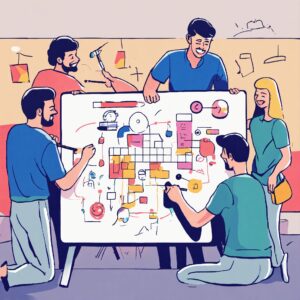App Development
App development services empower entrepreneurs and businesses to transform their ideas into functional and engaging mobile applications. These services provide expert guidance, technical resources, and ongoing support throughout the entire development lifecycle, from initial concept and design to coding, testing, deployment, and continuous improvement.

App Development Process
The App Development Process typically involves defining the app’s core functionality and user experience, creating a detailed technical blueprint, and allocating the necessary development resources. This is followed by building the application, rigorously testing its performance and usability, and iteratively refining features and addressing feedback to achieve the desired app outcomes.
Best Quality
Support
money back
guarantee
affordable
price
Case Study
Background: FreshStart Fitness is a local gym and personal training studio experiencing strong local interest but struggling to manage scheduling, client communication, and expand its reach beyond its physical location. While their in-person services were highly regarded, they lacked a digital presence to streamline operations and cater to a wider audience.
Objective: The primary objective of engaging app development services was to create a mobile platform to automate appointment booking, facilitate client communication, offer personalized training plans, and ultimately extend their services to a broader customer base, increasing revenue and brand visibility.
fAQ
frequently asked questions
App development is the process of creating software applications that run on mobile devices (like smartphones and tablets) or other digital platforms. This involves everything from initial concept and design to coding, testing, deployment, and ongoing maintenance and updates.
A well-developed app can be crucial for reaching and engaging your target audience, streamlining business processes, enhancing customer experience, and even creating new revenue streams. It can improve brand visibility, provide direct communication channels, offer personalized services, and gather valuable user data.
The timeline for app development can vary significantly depending on the complexity of the app, the features included, the platform(s) it’s being developed for (iOS, Android, or both), and the development team’s size and expertise. It can range from a few months for a simple app to a year or more for a complex, feature-rich application.
While there are no-code or low-code platforms that allow individuals with limited coding knowledge to create basic apps, developing a sophisticated and scalable app with custom features typically requires the expertise of professional app developers, UI/UX designers, and testers.
Key elements include a clear understanding of your target audience and their needs, a well-defined app concept and features, intuitive user interface (UI) and user experience (UX) design, robust and scalable code, thorough testing, a well-planned launch strategy, and ongoing maintenance and updates based on user feedback and evolving technology.
A mobile app strategy is a broader plan that outlines your business goals for having an app, your target audience, how the app will fit into your overall business strategy, and how you will measure its success. App development is the actual process of building and deploying the app based on that strategy. The strategy informs the development process.
The success of your app can be measured through various metrics, including the number of downloads, active users, user engagement (time spent in-app, features used), user retention rates, customer satisfaction (ratings and reviews), conversion rates (if applicable, like in-app purchases or lead generation), and the return on investment (ROI) of the development effort. Defining your key performance indicators (KPIs) early in the process is crucial.
We often use a “mobile-first” approach, designing for the smallest screens initially. Responsive design ensures the layout adapts seamlessly to all device sizes for optimal user experience.
We use style guides and design systems to maintain visual consistency. Thorough testing across various browsers, devices, and operating systems is crucial.
We actively follow industry blogs, attend webinars/conferences, participate in design communities, and experiment with new tools. Continuous learning is key in this evolving field.
